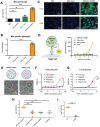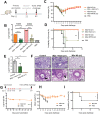Lymph Node Follicle-Targeting STING Agonist Nanoshells Enable Single-Shot M2e Vaccination for Broad and Durable Influenza Protection
- PMID: 37092580
- PMCID: PMC10265066
- DOI: 10.1002/advs.202206521
Lymph Node Follicle-Targeting STING Agonist Nanoshells Enable Single-Shot M2e Vaccination for Broad and Durable Influenza Protection
Abstract
The highly conserved matrix protein 2 ectodomain (M2e) of influenza viruses presents a compelling vaccine antigen candidate for stemming the pandemic threat of the mutation-prone pathogen, yet the low immunogenicity of the diminutive M2e peptide renders vaccine development challenging. A highly potent M2e nanoshell vaccine that confers broad and durable influenza protectivity under a single vaccination is shown. Prepared via asymmetric ionic stabilization for nanoscopic curvature formation, polymeric nanoshells co-encapsulating high densities of M2e peptides and stimulator of interferon genes (STING) agonists are prepared. Robust and long-lasting protectivity against heterotypic influenza viruses is achieved with a single administration of the M2e nanoshells in mice. Mechanistically, molecular adjuvancy by the STING agonist and nanoshell-mediated prolongation of M2e antigen exposure in the lymph node follicles synergistically contribute to the heightened anti-M2e humoral responses. STING agonist-triggered T cell helper functions and extended residence of M2e peptides in the follicular dendritic cell network provide a favorable microenvironment that induces Th1-biased antibody production against the diminutive antigen. These findings highlight a versatile nanoparticulate design that leverages innate immune pathways for enhancing the immunogenicity of weak immunogens. The single-shot nanovaccine further provides a translationally viable platform for pandemic preparedness.
Keywords: follicular dendritic cells; germinal center; lymph node follicle targeting; matrix protein 2 ectodomain antigen; nanoshell; stimulator of interferon genes agonist; universal influenza vaccine.
© 2023 The Authors. Advanced Science published by Wiley-VCH GmbH.
Conflict of interest statement
The authors declare no conflict of interest.
Figures







Similar articles
-
Single-Component Multilayered Self-Assembling Protein Nanoparticles Displaying Extracellular Domains of Matrix Protein 2 as a Pan-influenza A Vaccine.ACS Nano. 2023 Dec 12;17(23):23545-23567. doi: 10.1021/acsnano.3c06526. Epub 2023 Nov 21. ACS Nano. 2023. PMID: 37988765 Free PMC article.
-
Humoral Response to the Acetalated Dextran M2e Vaccine is Enhanced by Antigen Surface Conjugation.Bioconjug Chem. 2023 Aug 16;34(8):1447-1458. doi: 10.1021/acs.bioconjchem.3c00223. Epub 2023 Jul 17. Bioconjug Chem. 2023. PMID: 37458383 Free PMC article.
-
Complement C3 Plays a Key Role in Inducing Humoral and Cellular Immune Responses to Influenza Virus Strain-Specific Hemagglutinin-Based or Cross-Protective M2 Extracellular Domain-Based Vaccination.J Virol. 2018 Sep 26;92(20):e00969-18. doi: 10.1128/JVI.00969-18. Print 2018 Oct 15. J Virol. 2018. PMID: 30068650 Free PMC article.
-
M2e-based universal influenza A vaccine.Vaccine. 2009 Oct 23;27(45):6280-3. doi: 10.1016/j.vaccine.2009.07.007. Vaccine. 2009. PMID: 19840661 Review.
-
Vaccine options for influenza: thinking small.Curr Opin Immunol. 2018 Aug;53:22-29. doi: 10.1016/j.coi.2018.03.024. Epub 2018 Apr 7. Curr Opin Immunol. 2018. PMID: 29631195 Review.
Cited by
-
Polymerised superparamagnetic antigen presenting cell lymphocyte capture for enriching tumour reactive T-cells and neoantigen identification.Nat Commun. 2025 Jun 2;16(1):5088. doi: 10.1038/s41467-025-60321-3. Nat Commun. 2025. PMID: 40456725 Free PMC article.
-
A Single-Component Multilayered Self-Assembling Protein Nanoparticle Vaccine Based on Extracellular Domains of Matrix Protein 2 against Both Influenza A and B.Vaccines (Basel). 2024 Aug 28;12(9):975. doi: 10.3390/vaccines12090975. Vaccines (Basel). 2024. PMID: 39340007 Free PMC article.
-
Single-Component Multilayered Self-Assembling Protein Nanoparticles Displaying Extracellular Domains of Matrix Protein 2 as a Pan-influenza A Vaccine.ACS Nano. 2023 Dec 12;17(23):23545-23567. doi: 10.1021/acsnano.3c06526. Epub 2023 Nov 21. ACS Nano. 2023. PMID: 37988765 Free PMC article.
-
Engineered probiotic Escherichia coli elicits immediate and long-term protection against influenza A virus in mice.Nat Commun. 2024 Aug 9;15(1):6802. doi: 10.1038/s41467-024-51182-3. Nat Commun. 2024. PMID: 39122688 Free PMC article.
-
A novel "prime and pull" strategy mediated by the combination of two dendritic cell-targeting designs induced protective lung tissue-resident memory T cells against H1N1 influenza virus challenge.J Nanobiotechnology. 2023 Dec 13;21(1):479. doi: 10.1186/s12951-023-02229-y. J Nanobiotechnology. 2023. PMID: 38093320 Free PMC article.
References
-
- Subbarao K., Murphy B. R., Fauci A. S., Immunity 2006, 24, 5. - PubMed
-
- Belongia E. A., Kieke B. A., Donahue J. G., Greenlee R. T., Balish A., Foust A., Lindstrom S., Shay D. K., J. Infect. Dis. 2009, 199, 159. - PubMed
-
- a) Nachbagauer R., Feser J., Naficy A., Bernstein D. I., Guptill J., Walter E. B., Berlanda‐Scorza F., Stadlbauer D., Wilson P. C., Aydillo T., Behzadi M. A., Bhavsar D., Bliss C., Capuano C., Carreno J. M., Chromikova V., Claeys C., Coughlan L., Freyn A. W., Gast C., Javier A., Jiang K., Mariottini C., McMahon M., McNeal M., Solorzano A., Strohmeier S., Sun W., Van der Wielen M., Innis B. L., et al., Nat. Med. 2021, 27, 106; - PubMed
- b) Darricarrere N., Qiu Y., Kanekiyo M., Creanga A., Gillespie R. A., Moin S. M., Saleh J., Sancho J., Chou T. H., Zhou Y. F., Zhang R. J., Dai S. J., Moody A., Saunders K. O., Crank M. C., Mascola J. R., Graham B. S., Wei C. J., Nabel G. J., Sci. Transl. Med. 2021, 13, eabe5449; - PubMed
- c) Tseng Y. C., Wu C. Y., Liu M. L., Chen T. H., Chiang W. L., Yu Y. H., Jan J. T., Lin K. I., Wong C. H., Ma C., Proc. Natl. Acad. Sci. USA 2019, 116, 4200; - PMC - PubMed
- d) Laursen N. S., Friesen R. H. E., Zhu X., Jongeneelen M., Blokland S., Vermond J., van Eijgen A., Tang C., van Diepen H., Obmolova G., van der Neut Kolfschoten M., Zuijdgeest D., Straetemans R., Hoffman R. M. B., Nieusma T., Pallesen J., Turner H. L., Bernard S. M., Ward A. B., Luo J., Poon L. L. M., Tretiakova A. P., Wilson J. M., Limberis M. P., Vogels R., Brandenburg B., Kolkman J. A., Wilson I. A., Science 2018, 362, 598; - PMC - PubMed
- e) Lin P. H., Liang C. Y., Yao B. Y., Chen H. W., Pan C. F., Wu L. L., Lin Y. H., Hsu Y. S., Liu Y. H., Chen P. J., Hu C. J., Yang H. C., Mol. Ther. Methods Clin. Dev. 2021, 21, 299; - PMC - PubMed
- f) Boyoglu‐Barnum S., Ellis D., Gillespie R. A., Hutchinson G. B., Park Y. J., Moin S. M., Acton O. J., Ravichandran R., Murphy M., Pettie D., Matheson N., Carter L., Creanga A., Watson M. J., Kephart S., Ataca S., Vaile J. R., Ueda G., Crank M. C., Stewart L., Lee K. K., Guttman M., Baker D., Mascola J. R., Veesler D., Graham B. S., King N. P., Kanekiyo M., Nature 2021, 592, 623. - PMC - PubMed
Publication types
MeSH terms
Substances
Grants and funding
LinkOut - more resources
Full Text Sources
Medical
Research Materials
